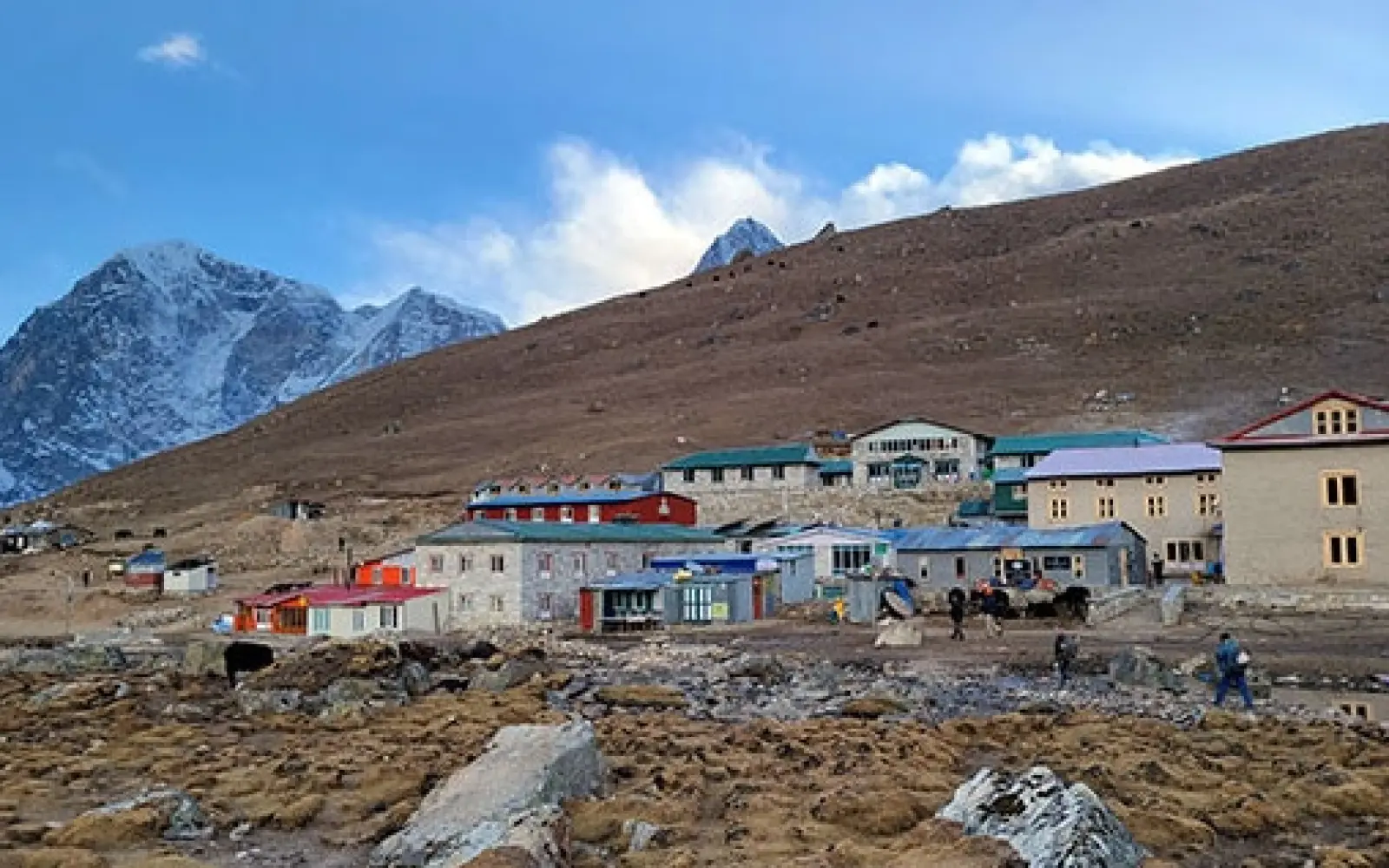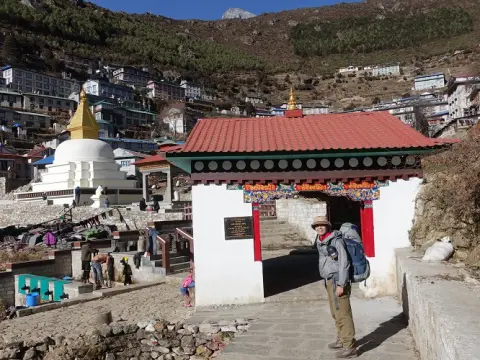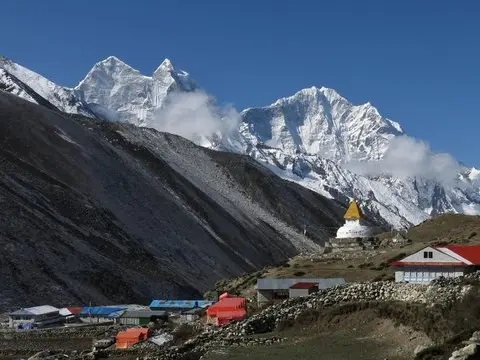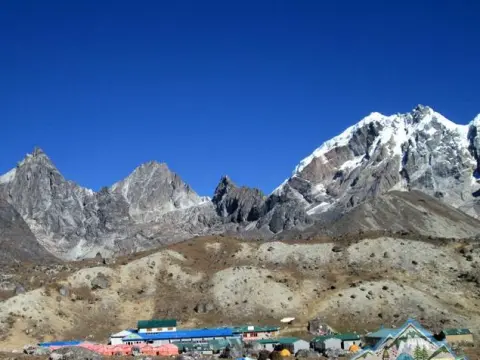Introduction
Lobuche is a small village in Nepal's famous Khumbu region. It stands at the lofty altitude of 4,910 meters (16,100 feet) above sea level. This qualifies it as one of the highest permanent settlements on the Everest trekking route. Trekkers often take a rest here after the final ascent to Everest Base Camp. Additionally, Lobuche offers stunning views of some of the world's highest mountains, including Pumori (7,161 m) and Nuptse (7,861 m). These behemoths surround the village, rendering it a regal village to behold. For this reason, Lobuche is a favorite among avid hikers and mountain lovers.In addition to Lobuche's astounding natural beauty, Lobuche is a culturally significant place. The village is occupied by the Sherpa people who have lived here for centuries. Their rich culture and warm hospitality welcome trekkers from all over the world. The village also has some tea houses and lodges which provide services to visitors. These provide a cozy resting space and recovery after strenuous days on the trekking path. Consequently, Lobuche serves as a cultural hub and rest stop for trekkers.Also, Lobuche's closeness to Everest Base Camp is a factor in its popularity. It is typically the last major stop for trekkers to acclimatize before reaching the base camp. The village is perched on the border of the Khumbu Glacier, offering unique views of the glacial terrain below. Similarly, its stark topography and high altitude give a feel of true Himalayan wilderness to its visitors. So, Lobuche is a combination of natural beauty, cultural richness, and trekking convenience.In conclusion, Lobuche is a significant and picturesque stop on the Everest trail. Its high altitude, spectacular mountain views, and Sherpa culture attract thousands of visitors annually. Visiting Lobuche gives trekkers a lifetime experience in Nepal's majestic Himalayas.Location and Geography
Lobuche is located in Nepal's Khumbu region, east of the small village of Gorak Shep. It stands at a high elevation of approximately 4,910 meters (16,100 feet). Because of this, it is one of the last villages before Everest Base Camp, which is at 5,364 meters (17,598 feet). This makes Lobuche a necessary stop for trekkers who are acclimatizing for the final ascent to the base camp. The village lies at the base of the Khumbu Glacier, the largest glacier in Nepal. The glacier comes down from the towering heights of the Everest range.The surrounding geography of Lobuche is dramatic and rugged. A few of the surrounding mountains include Pumori (7,161 meters), Nuptse (7,861 meters), and Lingtren (6,749 meters). These giants form a breathtaking skyline from the village. Additionally, the soil surrounding Lobuche is sparsely vegetated due to the unfavorable high-altitude climate. The area is typically covered by snow and ice, especially during the colder months. Therefore, the landscape is raw and unspoiled, with breathtaking views.Furthermore, Lobuche lies on the main Everest Base Camp trekking trail. The trail becomes steeper and more challenging here as trekkers approach it. The path winds its way through rock faces, moraine, and small streams. Owing to such a terrain, trekking must be physically fit and acclimatized. In addition to this, the area experiences extreme weather changes in the form of cold winds and occasional storms. Therefore, trekkers must be well-prepared for variable conditions.In total, the geography and location of Lobuche combine to create a unique mountain environment. It is a rugged village nestled among some of the highest mountains in the world. Additionally, its close proximity to the Khumbu Glacier endows it with spectacular natural beauty. The geography makes Lobuche a notable and unforgettable stop on the Everest trekking trail.Accessibility
Lobuche is accessible only on foot. There are no roads or vehicles that link this remote high-altitude mountain settlement. Therefore, all visitors must hike along the well-trodden trails of the Everest Base Camp route. The majority of trekkers visit Lobuche after hiking from Dingboche (4,350 meters) or Gorak Shep (5,164 meters). Lobuche is an important resting and acclimatization point for this reason.Also, the trek to Lobuche comprises steep inclines and uneven terrain. The path can be strenuous, especially for individuals who are not used to high elevations. Therefore, trekkers need good physical condition and endurance. The high elevation of 4,910 meters also calls for good acclimatization to avoid altitude sickness. A night halt here enables trekkers to acclimatize to the low air pressure.Additionally, the trail to Lobuche is underscored by breathtaking views that motivate trekkers irrespective of the difficulty. Along the way, you can see mountains such as Nuptse (7,861 meters) and Pumori (7,161 meters). Further, the trail passes near the Khumbu Glacier, which makes the landscape even more rewarding. However, the weather can sometimes make the trail slippery or risky. So, it is wise to check the weather forecast and carry suitable gear.There is no standard vehicle access, though helicopters can be used in the event of emergencies. Medical evacuation by helicopter is available in the event of serious altitude sickness or injury. Helicopter flights are, however, expensive and weather dependent. Trekkers are therefore encouraged to prepare to walk to Lobuche.In short, access to Lobuche is limited but typical of remote Himalayan towns. Trekking is the only feasible way of getting here. The challenge is well worth the trouble despite the difficulty, as the scenic payoff and cultural experience are enriching. Careful planning ensures a safe and comfortable trek to Lobuche.Facilities
Lobuche provides basic but necessary facilities for trekkers. Though it is remote and high in the mountains, it has some tea houses and lodges. They offer food, hot drinks, and simple accommodation. Most of the lodges have dormitory rooms with beds and blankets. So, trekkers can get a good sleep after exhausting days on the trail.Additionally, there is no much electricity in some of the tea houses, especially at night. The electricity is often provided by solar panels or small generators. However, the power outages are common, so the guests should not expect continuous electricity. Similarly, Wi-Fi connection is rare and slow. Thus, the tourists need to be ready to disconnect and get connected with nature entirely.Also, clean drinking water is widely accessible but must be boiled or filtered. Water supply is dependent on the melting of ice or nearby streams. Hot showers are uncommon and mainly cold due to limited heating. Trekkers thus must be prepared for basic hygiene facilities. Despite this, tea houses maintain cleanliness and hospitality to make guests comfortable.Likewise, there are stores at Lobuche that sell snacks, bottled water, and basic trekking gear. This is convenient for trekkers who have left something behind or need extra supplies. Some of the medical aid posts also give first aid and treatment for altitude sickness. These can be lifesavers for trekkers who experience health complications.Overall, facilities in Lobuche revolve around providing basic needs. They allow trekkers to rest and prepare for the final Everest Base Camp ascent. Though rudimentary, these services provide warmth, safety, and support in a hostile environment. Therefore, Lobuche remains a reliable stopover for adventure travelers in Nepal.Major Attractions
Lobuche offers several attractions that draw trekkers from all over the world. Firstly, its proximity to Everest Base Camp, situated at a height of 5,364 meters, makes it a key attraction. Trekkers stop here to rest and enjoy the breathtaking beauty of the Himalayas. You can see the towering heights of Everest (8,848 meters), Nuptse (7,861 meters), and Lhotse (8,516 meters) from Lobuche. These giants create a breathtaking and imposing skyline.Further, Lobuche is also close to the Khumbu Glacier, which is Nepal's largest glacier. Its icy formations create a spectacular and awe-inspiring natural wonder. Visitors can see deep crevasses and blue ice caves from paths close by. These wonders offer an excellent opportunity for photography and adventure.Apart from natural beauty, Lobuche also offers cultural experiences. The village is inhabited by Sherpas with rich customs and traditions. Trekkers generally witness prayer flags, mani stones, and small Buddhist shrines. These reflect the religious life of the region. Additionally, the annual Mani Rimdu festival in the region adds cultural color to the area.Besides, the memorial site in Lobuche is a tribute to Everest climbers who have passed away. The grave site is a reminder of the risks of the mountain. It provides a sense of respect and reflection for trekkers.Also, there are surrounding trekking routes that offer sidetrips to willing travelers. Treks to Chukhung, Kongma La Pass, and Island Peak base camp start from Lobuche. They offer less populous and more challenging experiences for experienced adventurers.Overall, the highlights of Lobuche mix Sherpa culture and nature's grandeur. It is a gateway to Everest Base Camp and offers unique Himalayan experiences. As a result, the village remains a favorite among trekkers seeking nature and adventure.Major Activities to do
There are several important activities that Lobuche is renowned for, which attracts trekkers and adventure lovers. The most prominent among them is trekking. Trekkers come to Lobuche as part of the much-hyped Everest Base Camp trek. It is a crucial acclimatization halt since it is at such a high elevation of 4,910 meters. Spending the night helps in acclimatization to prevent altitude sickness before the final climb to the base camp at 5,364 meters.Additionally, a few trekkers attempt to climb Lobuche East, a 6,119-meter peak. The climb provides stunning panoramic views of Everest, Lhotse (8,516 meters), and the other giants nearby. While technically challenging, the climb is inviting to serious mountaineers looking for adventure.Likewise,, nature watching and photography are also widely practiced by many visitors here. The location of the village provides stunning views of glaciers, peaks, and alpine landscapes. Under changing weather conditions, the mountains display dramatic lights and shadows. Photographers find Lobuche to be an excellent location for capturing Himalayan beauty.
Additionally, cultural experiences are also highly demanded activities in Lobuche. Visitors get exposure to Sherpa lifestyles and practices. Buddhist prayer ceremonies and festivals like Mani Rimdu are organized by the neighboring village. The events offer exhibitions of local traditions and spiritual heritage.
Another activity is to make day trips on side trails close by. Trekkers occasionally hike to the Khumbu Glacier or to memorials to Everest climbers who have lost their lives. These trips offer reflective moments and a greater appreciation of the mountain world. Others visit small Sherpa villages close to Lobuche for a sample of Sherpa hospitality.
Overall, Lobuche's offerings bring together trekking, mountaineering, culture, and nature. All these options make it a balanced destination for all kinds of travelers. Consequently, Lobuche remains a popular stop on the Everest trekking route.
What Is Lobuche Popular for?
Lobuche is popular because of some strong reasons. It is located on the Everest Base Camp trekking route. All the trekkers trekking to Everest pass through Lobuche. It is just 8 kilometers from the base camp at an elevation of 5,364 meters. Therefore, it is a significant resting and acclimatization point.Moreover, Lobuche's altitude of 4,910 meters helps trekkers adapt to the thin air in the mountains. A night here decreases the risk of high-altitude sickness. Thus, guides tend to recommend a visit to Lobuche before Gorak Shep or base camp. Hence, the village becomes a crucial point for safety and success.Also, Lobuche offers spine-tingling views of the neighboring peaks. Trekkers see Nuptse (7,861 meters), Pumori (7,161 meters), and even the Everest summit (8,848 meters). The landscape is stunning, with rocky outcrops and glaciers of ice. Camera hobbyists and nature lovers often cite it as one of the most scenic spots on the trail.Furthermore, the village provides access to some unforgettable experiences. Trekkers visit the memorials at Thukla Pass below Lobuche. The monuments commemorate climbers who have lost their lives on Everest. It adds emotional and historical value to the journey.Finally, Lobuche enjoys decent lodges and basic facilities for trekkers. The tea houses have hot meals, decent rooms, and warmth after cold hiking days. This combination of comfort and convenience makes it a popular choice.Culturally, Lobuche opens up Sherpa life to trekkers. Colorful prayer flags, mani walls, and stone stupas point to Buddhist influence. These religious aspects offer trekkers a cultural insight as they take a breather.In short, Lobuche is a winner because of its location, scenery, safety, and culture. It offers adventure and tranquility in Nepal's Khumbu region. So, no Everest trek is complete without visiting Lobuche.Accommodation and Tea Houses
Lobuche provides essential accommodation for trekkers en route to Everest Base Camp. The settlement has basic tea houses and lodges built for high-altitude trekking comfort. The buildings are wood and stone, designed to endure rough mountain winds. The rooms are small, most with twin beds, mattresses, and blankets. Therefore, trekkers enjoy good rest after a day's hike.In addition, the tea houses provide hot meals three times a day. Food consists of dal bhat, fried rice, noodles, soup, and tea. For breakfast, there is porridge, eggs, and pancakes. The meals provide energy for trekking in thin air and rough terrain. The food is plain but freshly prepared and satisfying.In addition, heating is available in dining areas using yak-dung or gas stoves. However, bedrooms are usually not heated due to limited fuel supply. Hence, trekkers must bring sleeping bags rated for sub-zero temperatures. Similarly, showers are rare and usually cold, with hot showers costing extra.Most lodges have shared toilets, often squat-style, with limited water. Some provide bucket flush or dry toilets due to freezing pipes. Solar panels or small generators supply limited electricity in the evening. Charging devices and using Wi-Fi usually requires an extra fee. Therefore, power and internet are not guaranteed at all times. Besides, the workers at Lobuche tea houses are welcoming and experienced. They offer advice, ask about visitors' health, and assist in high altitude sickness. Booking rooms in advance is advisable during peak seasons since space is limited. Spring and autumn trekking seasons are the busiest times. In conclusion, Lobuche tea houses provide trekkers with simple but stable accommodation. They may not be luxurious but are comfortable, secure, and provide hot food. Their welcome and location make them a requirement for Everest Base Camp treks.






